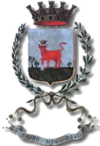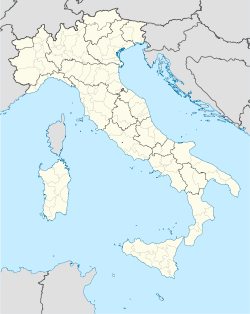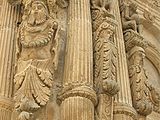- Nardò
-
"Nardo" redirects here. For other uses, see Nardo (disambiguation).
Nardò — Comune — Comune di Nardò 18th century column in Piazza Salandra 
Coat of armsLocation of Nardò in Italy Coordinates: 40°11′N 18°02′E / 40.183°N 18.033°ECoordinates: 40°11′N 18°02′E / 40.183°N 18.033°E Country Italy Region Puglia Province Lecce (LE) Frazioni Boncore, Cenate, Pagani, Palude del Capitano, Portoselvaggio, Roccacannuccia, Santa Caterina, Sant'Isidoro, Santa Maria al Bagno, Torre Inserraglio, Torre Uluzzo, Villaggio Resta Government – Mayor Antonio Vaglio Area – Total 190 km2 (73.4 sq mi) Elevation 45 m (148 ft) Population (November 2008) – Total 31,185 – Density 164.1/km2 (425.1/sq mi) Demonym Neretini Time zone CET (UTC+1) – Summer (DST) CEST (UTC+2) Postal code 73048 Dialing code 0833 Patron saint St. Gregory the Illuminator Saint day February 20 Website Official website Nardò is a town and comune of 31,185 inhabitants and comune in the southern Italian region of Apulia, in the province of Lecce.
Contents
History
Traces of human presence in the area dates from Palaeolithic times. The settlement was founded by the Messapi around the year 1000 BC. The Romans conquered it in 269 BC and built the Via Traiana through it. After the fall of the Western Empire it was under the Byzantines and the Lombards.
In 1055 the Normans captured Nardò. Their heirs were ousted by the Angevines in 1266. In 1497 the Aragonese gave it to Andrea Matteo Acquaviva, whose son Belisario was the first Duke of Nardò, and promoted the Renaissance in the city.
In 1647 the city rebelled against the Spanish domination, but the viceroyal troops suppressed the riot with heavy terms.
Geography
Civil parishes
The town counts 11 civil parishes (frazioni): Boncore, Cenate, Pagani, Palude del Capitano, Portoselvaggio, Roccacannuccia, Santa Caterina, Sant'Isidoro, Santa Maria al Bagno, Torre Inserraglio, Torre Uluzzo and Villaggio Resta.
Nardò DOC
The area around Nardò produces red and rose Italian DOC wines. The grapes are limited to a harvest yield of 18 tonnes/ha with the finished needing a minimum alcohol level of 12.5%. The wines are primarily composed of 80-100% Negroamaro with Montepulciano and Malvasia Nera permitted to fill in the remaining 20%.[1]
Main sights
This Baroque town in the heart of the Salento subpeninsula of the heel of Italy extending southeast between the Ionian and Adriatic Sea, has landscapes considered to be among the most beautiful in Italy, baroque monuments, baroque churches and masserie (typical ancient fortified farmhouses). The coast has sandy and rocky sections, but allows some lovely views of the Natural Park of Portoselvaggio. Its territory includes 34 km of Ionian Sea coast with ancient fishermen villages: Santa Maria al Bagno, Santa Caterina and Santo Isidoro.
- The Piazza Salandra is the center of the town.
- The notable Cathedral, built around 1000 AD. It has a 18th century façade, but the interior has maintained the Romanesque-Gothic original appearance.
- Church of San Domenico (16th-18th centuries). It has a highly decorated façade with Baroque caryatids, columns and vegetable figures.
- Chiesa del Carmine, with a fine Renaissance portal.
- Church of San Cosimo (1618)
- Temple of the Osanna (1603)
- Nardò Ring in Nardò is used as a test track for driving in high speeds.
Photogallery
Sister cities
 Hof Hacarmel Atlit, Israel
Hof Hacarmel Atlit, Israel Fiorano Modenese, Italy
Fiorano Modenese, Italy Conversano, Italy
Conversano, Italy Gyumri, Armenia
Gyumri, Armenia
References
- ^ P. Saunders Wine Label Language pg 186 Firefly Books 2004 ISBN 1552977200
External links
- Views of the Baroque land of Nardò
- Useful information and contacts about Nardò
- How to get to Nardò
- Puglia Photo Gallery
- Nardò coast live webcam
Categories:- Cities and towns in Apulia
- Communes of the Province of Lecce
- Localities of Salento
- Baroque sites of Apulia
Wikimedia Foundation. 2010.




